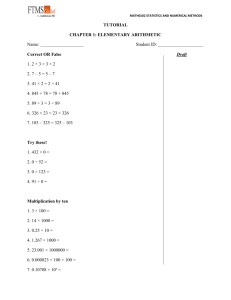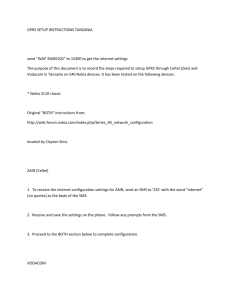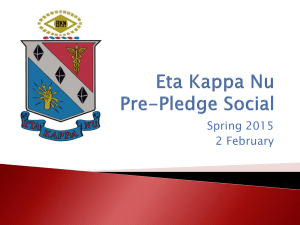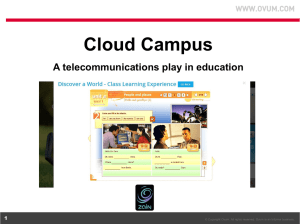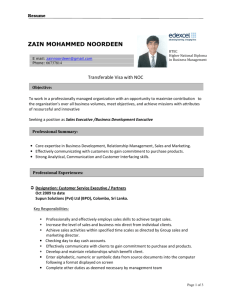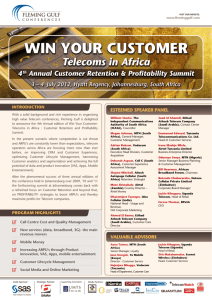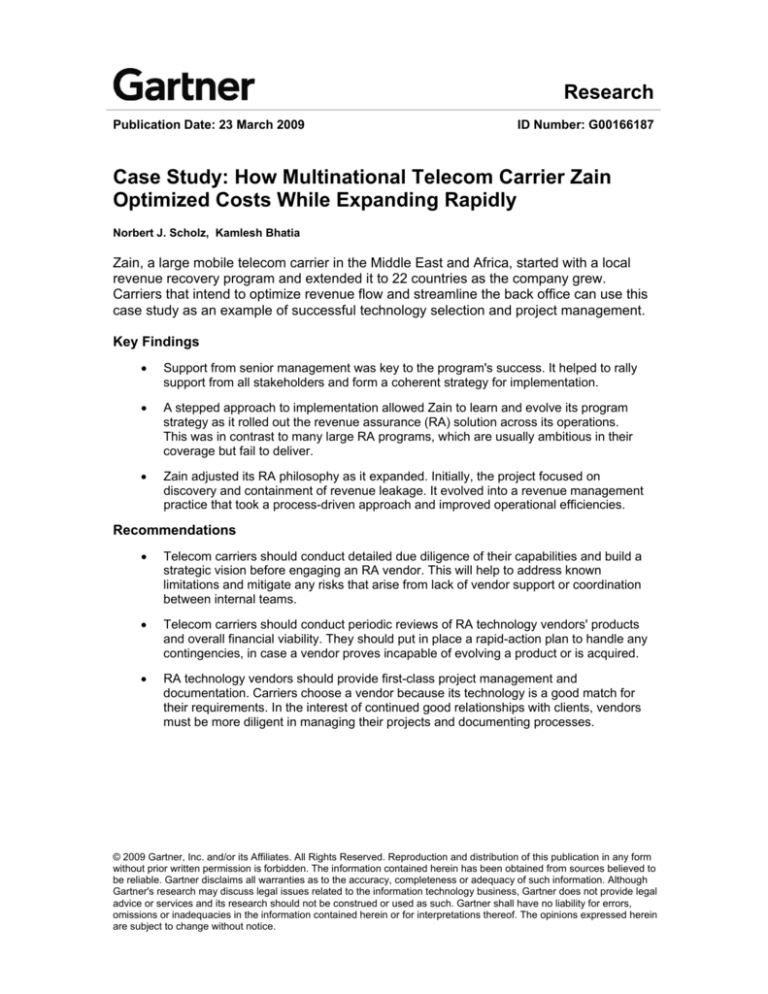
Research
Publication Date: 23 March 2009
ID Number: G00166187
Case Study: How Multinational Telecom Carrier Zain
Optimized Costs While Expanding Rapidly
Norbert J. Scholz, Kamlesh Bhatia
Zain, a large mobile telecom carrier in the Middle East and Africa, started with a local
revenue recovery program and extended it to 22 countries as the company grew.
Carriers that intend to optimize revenue flow and streamline the back office can use this
case study as an example of successful technology selection and project management.
Key Findings
•
Support from senior management was key to the program's success. It helped to rally
support from all stakeholders and form a coherent strategy for implementation.
•
A stepped approach to implementation allowed Zain to learn and evolve its program
strategy as it rolled out the revenue assurance (RA) solution across its operations.
This was in contrast to many large RA programs, which are usually ambitious in their
coverage but fail to deliver.
•
Zain adjusted its RA philosophy as it expanded. Initially, the project focused on
discovery and containment of revenue leakage. It evolved into a revenue management
practice that took a process-driven approach and improved operational efficiencies.
Recommendations
•
Telecom carriers should conduct detailed due diligence of their capabilities and build a
strategic vision before engaging an RA vendor. This will help to address known
limitations and mitigate any risks that arise from lack of vendor support or coordination
between internal teams.
•
Telecom carriers should conduct periodic reviews of RA technology vendors' products
and overall financial viability. They should put in place a rapid-action plan to handle any
contingencies, in case a vendor proves incapable of evolving a product or is acquired.
•
RA technology vendors should provide first-class project management and
documentation. Carriers choose a vendor because its technology is a good match for
their requirements. In the interest of continued good relationships with clients, vendors
must be more diligent in managing their projects and documenting processes.
© 2009 Gartner, Inc. and/or its Affiliates. All Rights Reserved. Reproduction and distribution of this publication in any form
without prior written permission is forbidden. The information contained herein has been obtained from sources believed to
be reliable. Gartner disclaims all warranties as to the accuracy, completeness or adequacy of such information. Although
Gartner's research may discuss legal issues related to the information technology business, Gartner does not provide legal
advice or services and its research should not be construed or used as such. Gartner shall have no liability for errors,
omissions or inadequacies in the information contained herein or for interpretations thereof. The opinions expressed herein
are subject to change without notice.
WHAT YOU NEED TO KNOW
Zain is a large multicountry mobile telecom carrier with operations spread across the Middle East
and Africa (for corporate details, see Note 1). It has implemented an integrated RA program in
partnership with Connectiva Systems (see Note 2). The program, which started as a "point"
implementation, has resulted in significant savings for Zain and expanded to include the
company's entire operations across 22 countries. The success of this program has largely
resulted from the dedicated focus of Zain's internal RA team and effective support from
Connectiva.
This document can serve as a reference for other telecom carriers in the process of implementing
or enhancing RA programs.
CASE STUDY
Introduction
The emergence of RA as a distinct discipline has raised awareness among telecom carriers that
they are losing money because of misaligned business support system and operations support
system solutions and processes. During the past five years, many carriers have launched
initiatives to contain revenue leakage, but new content services and bundles are likely to open the
door to new leaks. Losses in upper-single to lower-double-digit percentages could become the
norm unless carriers take further action.
Zain is a multinational mobile carrier headquartered in Kuwait. It provides an example of how a
small local initiative can expand into a multinational endeavor. In 2003, Zain, then operating as
MTC Vodafone, launched an RA initiative and almost instantly recovered $15 million on an
investment of $2 million. The carrier chose Connectiva as its strategic partner. For details, see
"Best Practices in Revenue Assurance: MTC-Vodafone Kuwait Recovers $15 Million."
Since then, Zain has grown exponentially. The company now operates in 22 Middle Eastern and
African countries, serves around 65 million subscribers and has annual revenue of nearly $7.5
billion. It plans to increase its number of subscribers to 110 million by 2011. Zain has introduced
new content services and hopes to derive a large percentage of its revenue from e-commerce in
the next five years. This move would make Zain resemble a bank, with all the associated
regulatory and licensing entanglements.
In 2006, Zain launched its One Network, which allows members to communicate across borders
without roaming surcharges or fees for receiving incoming calls. Zain aims to link all its operations
through One Network.
Rapid growth, geographic dispersion and a changing revenue stream have resulted in new
challenges. Zain had to rethink its RA philosophy. As the company grew, so did its RA
organization. Having started with a single employee in 2003, it now has 170 full-time staff and a
cross-departmental Revenue Advisory Committee with participation from IT, network/technical
and commercial (sales and marketing) teams. This case study serves as an example for carriers
on how to adapt localized initiatives to changing realities.
Challenges
Initially, Zain's revenue leakage was related to a decade-old billing system. In 2003, the company
hired an RA manager, made him report directly to the CFO, and instructed him to fix the leak.
Rather than solving the problem in-house, Zain partnered with Connectiva, a New York-based
Publication Date: 23 March 2009/ID Number: G00166187
© 2009 Gartner, Inc. and/or its Affiliates. All Rights Reserved.
Page 2 of 8
vendor specializing in revenue management solutions. The project went so well that Zain decided
to expand the use of Connectiva's Onereview RA platform to other group properties.
As the company expanded geographically and introduced new services, the complexities of
revenue leakage multiplied. Each of its new properties had its own billing platforms, mediation
systems and CRM systems sourced from different vendors. In some operations, data was
outdated, corrupted or generally unavailable for analysis. Moreover, the company had to grapple
with various regulatory requirements and standards, and needed to align disparate business
processes.
Key challenges included:
•
Efficiently managing large volumes of data while avoiding redundant data processing.
•
Achieving proactive risk mitigation through institutionalized best practices.
•
Ensuring consistency and completeness in reporting across the entire operation.
•
Managing data integrity issues.
Zain realized that it would have to change its RA philosophy from one that focused on the
discovery and containment of revenue leakage to a revenue management practice that adopted a
process-driven approach and improved operational efficiencies. The RA platform of choice would
have to be able to adapt to undefined future requirements and be flexible enough to scale up with
anticipated future growth.
Approach
Zain pursued a dual approach to revenue management. Standardization and centralization
ensured cost savings, streamlined operations and provided better insights into operations at
group level. Working with external suppliers helped overcome internal skills shortages and
ensured process automation. Support from senior management helped to "onboard" personnel
from acquired companies and form a coherent strategy.
Standardization and Centralization
As it expanded, Zain made it a priority to consolidate and standardize its business processes, and
to develop and implement standard tools, policies and procedures based on the eTOM model.
Zain sought to centralize operations through fewer data centers and to use manpower efficiently
in local, regional and head offices. The focus was on learning from one operation in order to
proactively fix problems in others.
One focus of the centralization and standardization approach was revenue management. Zain set
up a centralized operation to oversee key functions such as billing and network operations,
service-level agreement (SLA) monitoring and reporting, and standardization of systems and
processes. The initial success in Kuwait diffused some reluctance in regional organizations to
come on board. It is company policy to leverage RA resources across countries to manage
emerging issues. After resolution, these resources return to their home base.
External Vendor Selection
Zain could have developed its own RA platform, but did not do so as software development was
not its core competency. Its geographic dispersion necessitated automation in the processing of
complex data streams and advanced and complex investigative analysis.
Publication Date: 23 March 2009/ID Number: G00166187
© 2009 Gartner, Inc. and/or its Affiliates. All Rights Reserved.
Page 3 of 8
The carrier had been working with Connectiva's Onereview RA platform since 2004. Initially, the
solution covered traffic, rating and billing analysis, and subscriber profile assurance across all
product and service offerings, such as voice, Short Message Service and data services. Zain
gradually expanded the platform to identify core network issues, to perform financial analysis and
fraud management, and to review revenue performance. The carrier used the solution to provide
data for third-party business intelligence (BI) and data warehousing systems by capitalizing on its
extensive data-processing capabilities. It used the solution's extraction, transformation and
loading (ETL) features to help other departments produce specific reports from raw data, which
partly compensated for the lack of comprehensive BI capabilities and saved on license costs.
Zain evaluated Connectiva against other ETL suppliers and decided to stick with Connectiva
because of its flexibility with enterprise data management capabilities, its ease of deployment,
its scalability and its proven track record for handling large record volumes in near real time.
The solution also offers predictive qualities based on historical data, which could help to identify
potential shortfalls in the future. Finally, it is a standards-based platform that works on many
different technology platforms — a primary requirement for a multinational carrier like Zain.
Support From Senior Management
Zain's RA program garnered support from senior executives, including the CFO. This helped to
bring on board personnel from acquired companies and to form a coherent strategy. This in turn
facilitated the implementation of improvement initiatives and raised awareness across the
organization.
The formation of a cross-departmental Revenue Advisory Committee headed by a dedicated RA
manager further encouraged participation and increased the chance of the project succeeding.
Results
Operational Benefits
The carrier got control over the loopholes in network components deployed and developed a
better understanding of revenue-generating processes. It requested that the network vendors
make the recommended changes, which reduced leakage and eventually increased earnings
before interest, tax, depreciation and amortization (EBITDA) margins.
Zain can now use the same data sets for multiple analyses. This has largely removed redundant
information and has given it a better view of its customers and processes. Zain is in the process
of extending Connectiva's capabilities. This includes processing large volumes of data efficiently
and ensuring that any leakage in its operations is quickly stopped. This is important in the context
of linking all Zain's operations through the concept of One Network.
Financial Benefits
The RA initiative has resulted in reductions in total cost of ownership (TCO) and operational
expenditure for Zain, for several reasons:
•
With the standardization of techniques, the revenue recovery cycle has become faster.
•
There has been a considerable reduction in hardware and third-party license costs due
to the volume discounts that Zain receives from its suppliers.
•
By optimizing the use of expensive hardware and personnel, the company reduced the
cost of integration and maintenance of data interfaces within a short time.
•
More efficient use of resources has reduced operational expenditure and lowered TCO.
Publication Date: 23 March 2009/ID Number: G00166187
© 2009 Gartner, Inc. and/or its Affiliates. All Rights Reserved.
Page 4 of 8
•
There is across-the-board visibility into the financial performance of each regional
operation.
Challenges
As with any large project, not everything went smoothly. Some of the sticking points had to do
with Zain's internal operations, while others can be attributed to Connectiva having to keep up
with changing requirements and deploy 14 sites simultaneously in a relatively short time. The
sticking points had more to do with organization and governance than with technology.
Internally, some of Zain's regional units lacked the expertise and staff to manage the RA tool.
High turnover in some teams aggravated the situation. Also, simultaneous installations across
various operations stretched Zain's in-house team.
In some cases, Connectiva faced the task of providing equivalent levels of post-implementation
services for all Zain operations. Due to rapidly changing deliverables and aggressive time lines,
Zain's smaller operations may not have received the same level of attention as the larger ones.
Critical Success Factors
Early success: The success of the initial revenue recovery project in Kuwait set an example of
the right approach for the entire company. As a best practice, it helped bring the regional units on
board. Zain soon managed to duplicate the success in Iraq, where it achieved a positive return on
its investment in less than six months.
Centralization and standardization: Zain pursued a policy of standardizing and centralizing its
operations. This resulted in improved efficiencies, cost savings, better governance and higher
visibility into the group's operations.
Evolution philosophy: The initiative started with the discovery and containment of revenue
leakage in a single location and evolved into a revenue management practice that adopted a
process-driven approach and focused on operational efficiencies. In future, the focus will shift to
risk management and nontraditional transactional analysis. This evolution will enable Zain to
address future challenges proactively.
Partnership with external suppliers: Zain realized its skills limitations early on. Instead of trying
to build a revenue management solution internally, it selected a best-of-breed solution and
expanded its scope incrementally. This saved it from costly and potentially futile internal
development work and gave it a head start to manage its revenue stream.
Periodic evaluation of the solution deployed: Zain periodically evaluates whether its suppliers
still meet its technical requirements and remain viable. This ensures the commitment of its
suppliers and reserves the option of replacing them if they no longer meet its requirements.
For example, Zain reworked its SLAs with Connectiva after deciding to expand the use of the
solution.
Lessons Learned
Advice for carriers planning to launch or expand an RA initiative:
Start small and score early successes: Early success will galvanize the entire organization and
bring reluctant units on board. As an overlay to existing departments, an RA organization needs
such success to underscore its credibility.
Publication Date: 23 March 2009/ID Number: G00166187
© 2009 Gartner, Inc. and/or its Affiliates. All Rights Reserved.
Page 5 of 8
Explore how you can use the solution for related purposes: Many RA tools can be used in
adjacent disciplines such as fraud management, BI and risk management. Expanding the scope
of existing solutions could help in reducing the number of suppliers.
Be realistic about your capabilities: There are many viable solutions on the market. If in-house
expertise is insufficient, it's usually best to look for external suppliers.
Manage the vendor: Technology alone doesn't guarantee success. It's equally important to
manage the project, ensure sufficient staffing and document every step of the project. Vendors
sometimes focus on their technology and neglect to manage the project.
Choose a supplier that can grow with you: Selecting a revenue leader might not always be the
best option. Small and midsize vendors with good solutions tend to be more responsive and more
willing to integrate carriers' requirements into their product road maps.
Advice for vendors supporting RA initiatives:
Adapt your solution to changing client requirements: RA remains an ill-defined concept.
Despite its official branding, vendors should be flexible enough to use their solution's dataprocessing capabilities for adjacent disciplines such as fraud management, risk management
and BI.
Don't underestimate the value of small projects: It's natural to focus on "marquee" projects,
but often it's small projects that set a precedent and that make or break relationships with clients.
Provide first-class project management and documentation: Customers choose a vendor
because its technology is a good match for their requirements. Project management is often an
afterthought. Yet it is often project management that makes or breaks projects. In the interest of
continued good relationships with their clients, vendors must be more diligent in managing
projects and documenting processes.
RECOMMENDED READING
"Best Practices in Revenue Assurance: MTC-Vodafone Kuwait Recovers $15 Million"
"How to Select a Revenue Assurance Solution from Vendors with a Multi-Industry Background"
"How to Select a Revenue Assurance Solution from Vendors with an RA Specialist Background"
Note 1
Zain
Company Name: Zain Group (formerly MTC or Mobile Telecommunications Company)
Address: Shuwaikh, Airport Road, Kuwait, 3083 Kuwait
Main Phone Number: +965 4644444
Web Site: www.zain.com
Founded: 1983
Employees: 16,000 approximately
Financial Data: US$7.44 billion in revenue (2008)
Publication Date: 23 March 2009/ID Number: G00166187
© 2009 Gartner, Inc. and/or its Affiliates. All Rights Reserved.
Page 6 of 8
Mission: "Zain aims to be a leading global mobile operator that provides professional, worldclass mobile and data services to all our customers, wherever they are, worldwide. Zain intends
to achieve this in three stages: regional, international and global, with each stage completed in
three years, with an aim of reaching a subscriber base of 110 million. Zain aim to achieve in nine
years what other companies have taken more than 27 years to achieve."
Profitability: US$1.2 billion net (2008)
Note 2
Connectiva Systems
Company Name: Connectiva Systems
Address: 19 West 44th Street, Suite 611-612, New York, NY 10036, United States of America
Main Phone Number: +1 646 722 8741
Web Location: www.connectivasystems.com
Founded: 2001
Employees: 400 approximately
Financial Data: approximately US$25 million to $30 million in revenue in 2008 (Gartner estimate)
Profitability Remarks: Profitable, backed by the International Finance Corporation (IFC), NEAIndoUS Ventures, Ovation Capital and SAP Ventures
Strategic Partners: Oracle, IBM, HCL Technologies, Tata Consultancy Services (TCS),
Ericsson, T-Systems and SAP
Publication Date: 23 March 2009/ID Number: G00166187
© 2009 Gartner, Inc. and/or its Affiliates. All Rights Reserved.
Page 7 of 8
REGIONAL HEADQUARTERS
Corporate Headquarters
56 Top Gallant Road
Stamford, CT 06902-7700
U.S.A.
+1 203 964 0096
European Headquarters
Tamesis
The Glanty
Egham
Surrey, TW20 9AW
UNITED KINGDOM
+44 1784 431611
Asia/Pacific Headquarters
Gartner Australasia Pty. Ltd.
Level 9, 141 Walker Street
North Sydney
New South Wales 2060
AUSTRALIA
+61 2 9459 4600
Japan Headquarters
Gartner Japan Ltd.
Aobadai Hills, 6F
7-7, Aobadai, 4-chome
Meguro-ku, Tokyo 153-0042
JAPAN
+81 3 3481 3670
Latin America Headquarters
Gartner do Brazil
Av. das Nações Unidas, 12551
9° andar—World Trade Center
04578-903—São Paulo SP
BRAZIL
+55 11 3443 1509
Publication Date: 23 March 2009/ID Number: G00166187
© 2009 Gartner, Inc. and/or its Affiliates. All Rights Reserved.
Page 8 of 8

